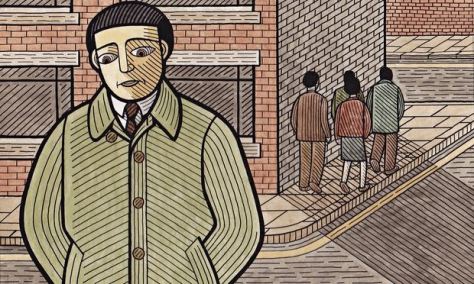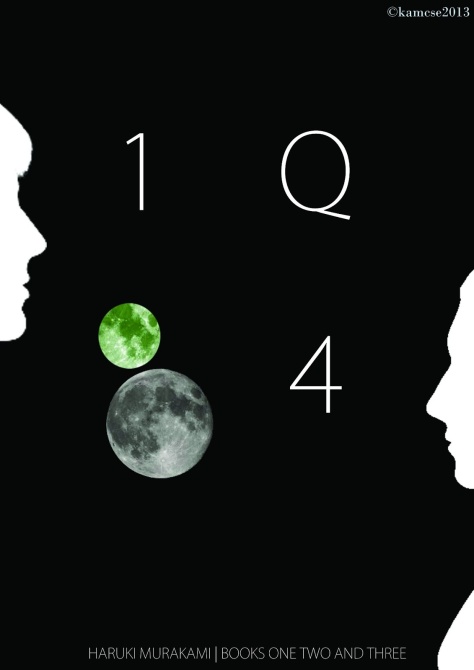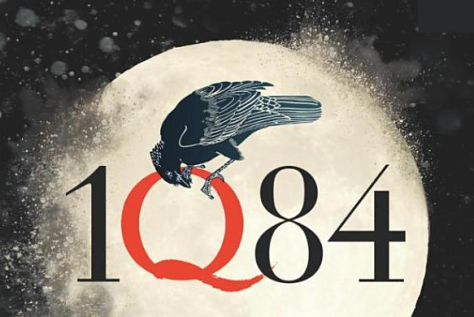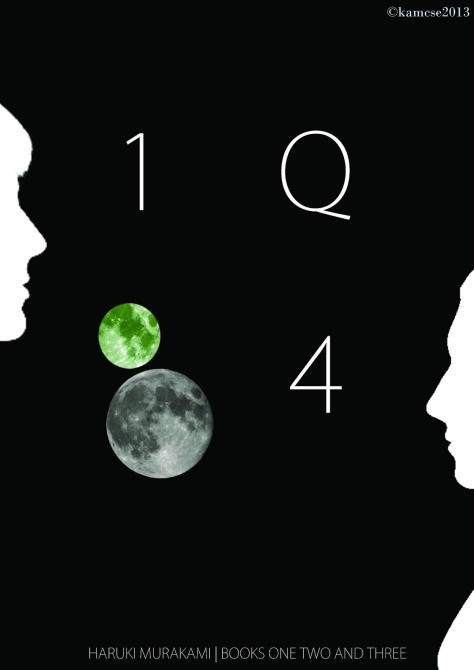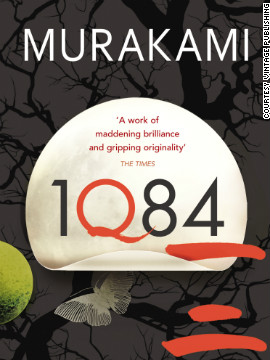From Matthew Carl Strecher’s The Forbidden Worlds of Haruki Murakami:
“One of the more diverting aspects of Murakami criticism has been the flurry of speculation about direct literary ‘influences’ and ‘antecedents’ that seem to attend each new work…
Tazaki Tsukuru has been no exception to this kind of interest, not for its title but because of the prominent color imagery that seems to demand a bit more than the usual attention. Works of fiction offered by Japanese critics as having possible connection with Tazaki Tsukuru include ‘The Pursuit of Mr. Blue’ in G.K. Chesterton’s Father Brown mysteries, Paul Auster’s Ghosts, and certain works on color by Johann Wolfgang von Goethe and Rudolf Steiner. These last two, suggested by Numano Mitsuyoshi, are not far off the mark, as we shall see. And while I customarily avoid these games, not wishing to become embroiled in yet another wild sheep chase, I would be ready to wager a small sum on the relevance, if not the definitive influence, of Aldous Huxley’s nonfiction work The Doors of Perception, for reasons that will be made clear below.
On the evening prior to Tazaki’s second dream, the topic of his discussion with Haida turns to the nature of death, a subject to which Tazaki has given quite a bit of thought, and this occasions Haida to share a peculiar story he claims to have heard from his father, but which he tells so expertly that Tazaki suspects it may actually be his own. During the 1960s, as the story goes, while still a university student, Haida’s father grows tired of the constant strife among the various radical student factions and leaves school to go on a one-year walking tour of Japan (resembling Rat’s journey in Pinball, 1973, and A Wild Sheep Chase), eventually landing at a secluded hot spring resort in the mountains of Oita Prefecture. There he meets a jazz pianist named Midorikawa (green river), a middle-aged man who has determinedly avoided unnecessary human contact while staying at the inn. He takes a liking to Haida’s father, however, particularly after the latter guides him to a nearby public school to use the piano in their music room. While performing a spellbinding rendition of Theolonius Monk’s ‘Round Midnight,’ Midorikawa keeps a small pouch on the piano. Asked what it is, he responds first that it is ‘a kind of talisman,’ then clarifies that ‘you might call it my other self.’
But Midorikawa has far more interesting secrets to tell. He confides that he is a carrier of something known as the ‘death token,’ and while we are never told clearly what this means, to be chosen as its carrier, one must first accept the responsibility of facing death willingly. In exchange for this, one is granted special powers of perception not given to ordinary people. In Midorikawa’s case, it is the ability to see the ‘lights and colors’ that surround all people like an aura. What this glow represents is open to interpretation, but I am inclined to agree with Numano’s contention, leaning on Goethe and Steiner, that these represent the actual ‘souls’ of the individuals he sees. For Midorikawa this ‘gift’ is very much a mixed blessing, however; it was because he was sick of seeing into men’s souls that he came to this isolated mountain retreat, where he now awaits his own death, due to arrive within the next two months. The carrier of the ‘death token’ is given but one chance to avoid his impending death; he must find someone – a person with the just right sort of color and glow, ‘maybe one in a thousand, or two thousand,’ as Midorikawa puts it – who will, in full knowledge of the consequences, take up the burden of the ‘death token’ for him. Asked what sort of person willingly accepts such a fate, Midorikawa says it might be ‘the sort of person who is unafraid of making a great leap.’
Presumably, Midorikawa has shared this tale with Haida’s father because he sees that special ‘light and color’ in him as well. He does not, however, invite the young man to take up the death token in his place; he merely offers him a few avuncular words of advice, simple, yet moving: Midorikawa tells him that he is different from most people, that he is not meant simply to live and then die ‘like a cat, alone, in some dark place.’ Rather, he must strive always to live fully. ‘Soon you will return to your life in Tokyo,’ I suppose,’ Midorikawa told him in a quiet voice. ‘Then you will go back to your real life. Live that life fully. Even if you meet with frivolity and monotony, there is value simply in living this life.’ The following day Midorikawa disappears for good, and Haida’s father never learns what became of him.
Why does Haida tell Tazaki this story? On the surface it is a chance to introduce his friend to the idea of a heightened, indeed transcendent, sense of perception and to give graphic narrative expression to his theory of free thought. In terms of driving the novel forward, it serves to highlight the existence of certain ‘gifted’ persons in the world, much as we saw in 1Q84, who possess extraordinary powers of perception. Midorikawa describes his own heightened perception as follows:
‘At the moment you have agreed to take up the burden of death, you possess an unusual quality. You could call it a special ability. The ability to read the various colors given off by people is only one of those functions. At the root of it, you are able to expand your perception. You push open that ‘door to perception’ that Aldous Huxley talked about. And then your perceptions are pure and genuine.’
……
If Midorikawa and Haida represent ‘the elect,’ so to speak, those who possess a special light and color that permits them heightened powers of perception, then it is Aka and Ao who represent and minister to the ‘ordinary people’ who do not have these powers. This is most explicitly expressed through Aka, whose business is educating new company employees and reeducating those in midcareer. Aka sees himself as a visionary – ‘I wasn’t made to be used by others,’ he rather smugly informs Tazaki – and believes that his company performs a noble service, training workers to think for themselves. This liberation of the mind, however, has its limitations. ‘We are trying to create a workforce that can say, ‘I can use my own head to think about things,’ while continuing to work within the expectations of the company,’ he tells Tazaki. Whether Aka’s goal is people who actually can use their own heads or simply people who can say that they do is a matter of some ambiguity; that their thinking must remain ‘within the expectations of the company’ is a not very subtle way of reminding us that whatever illusions of free thought they may have, such people are still pawns of the System.
This, of course, places some limits on what sorts of people are suitable for the kind of System-approved training Aka has to offer. As a matter of expediency he divides his potential clientele into three categories:
‘There are quite a lot of people who can’t accept our program. I divide them into two types: first is the antisocial person. The English term is ‘outcaste.’ These people reject established attitudes, they won’t accept them. Or else they won’t be bound by the collective rules. Working with them is a waste of time. We can only ask them to leave. The other type is the person who can truly use his head and think. WE can leave them alone. Better not to fiddle with them and screw them up. Every system needs a representative like that. If they can stay on the path, they eventually end up in charge. But in between these two groups, there is a layer of people who simply take orders and carry them through, and they occupy a large chunk of the population – I would estimate about 85% of it. Our business is built on the foundation of the 85%.’
Aka’s clientele, then, are the mediocre, the ordinary, and they are implicitly opposed to those like Midorikawa and Haida, both of whom are capable of looking and thinking beyond accepted boundaries. In contrast to the ‘expectations of the company,’ Haida’s philosophy requires a willingness to break out of those expectations, to reach escape velocity and shoot for unknown galaxies. ‘All things have a framework,’ he tells Tazaki. ‘Thought also has its limits. There is nothing to be feared in boundaries, but we also must not be afraid to smash those boundaries. In order for humankind to be free, this is more important than anything. Reverence and abhorrence for limits. Everything important in human life is grounded in this duality.’ Clearly Haida represents the ‘incorrigible’ group, for his refusal to ‘stay inside the lines.’ Aka, on the other hand, represents the cream of society’s mediocrity, creating not freethinkers but the illusion of freethinking, for he is still bound up by the rules. Ao, too, for all his expressed distaste for the kind of company Aka runs, is part of this great mediocrity. Ao sells the Lexus brand – Toyota’s luxury model, meant to tap into the middle class’s desire to enjoy the illusion of being upper-class. It is fitting that Ao’s mobile phone ringtone is ‘Viva Las Vegas,’ for if ever there was a city that embodied the façade, the false front, it surely must be Las Vegas. Ao harbors no illusions about this, admitting that the brand name Lexus ‘has no meaning at all. It’s just a made-up word. Something a New York advertising firm came up with in response to Toyota’s request for a name that sounded high class and meaningful, with a nice ring to it.’
And what of Tazaki Tsukuru? It would be safe to say that Tazaki begins the work, more or less by accident, in the same group as Aka and Ao, but that the traumatic experiences of his youth prove transformative for him, nudging him closer to his true destiny, which is to join the ‘elect.’ This, one suspects, is the message that Haida wishes so fervently to convey to Tazaki on the night of his second dream – the very reason, in fact, that he told Tazaki the story of Midorikawa in the first place. Tazaki, however, is not yet prepared to receive and decipher that message, so Haida finds another way of getting his attention, of demonstrating the separation of spirit and flesh…
Having come this far, let us now pause to reexamine some of the earlier Murakami characters who possess remarkable abilities and use those talents to assist others: the clairvoyant ear model Kiki from A Wild Sheep Chase and Dance Dance Dance; Naoko and her attunement to the world of the dead in Norwegian Wood; the clairvoyant girl Yuki in Dance Dance Dance; Okada Toru’s ability to divide flesh and spirit; Nakata and Saeki in Kafka on the Shore; Tengo, Aomame, Fukaeri, Ushikawa, and the Leader in 1Q84. It is not until 1Q84, however, that we begin to see an acute consciousness of these gifts on the part of the characters they adorn, as well as some inkling of the consequences that must attend those gifts – including the willingness to be sacrificed for the sake of the great good, as occurs with the Leader and Ushikawa, and very nearly with Aomame and Tengo as well.
In many of these instances, the ‘gifted’ person possesses some physical sign of his or her ability. The clairvoyant from A Wild Sheep Chase has ears so exquisite that those who see them are likely to experience spontaneous orgasms. Okada Toru bears a mark on his cheek. Tengo and the Leader have their extraordinary size; Aomame, the imbalance in the size of her breasts (and her frightening grimaces); and Ushikawa, his ugliness. Haida has the scar on his neck, while Midorikawa carries something in a pouch with him wherever he goes.
…
This motif remains largely intact in Tazaki Tsukuru as well. Among the characters, it is not difficult to identify the four who possess something special, beyond the abilities of ordinary people, as Shiro, Haida, Midorikawa, and, of course, Tazaki himself. All four of these characters have in common a connection with the world of death. Midorikawa, as a carrier of the ‘death token,’ stares that world in the face daily, awaiting its advent; Haida, as suggested previously, is probably dead already; Shiro, for an unspecified period of time – perhaps her whole life – has been communicating with the world of the dead, gradually moving closer to it; and Tazaki, following his expulsion from the group, carries a mental imprint of the abyss into which he stared for five long months. And while their ‘gifts’ are not as dramatic as those of Aomame, Tengo, or the Leader, they are nonetheless remarkable. For Shiro, the gift is musical; what she lacks in mechanical technique she makes up for in feeling and emotion as she plays the deceptively difficult Le Mar du Pays. Midorikawa possesses the ability to see the ‘light’ and ‘color’ that surrounds all people – in short, he can see their souls. Haida, like Okada Toru, is able to divide his flesh and spirit and thus to move beyond the boundaries of ordinary human thought. And what is Tazaki’s ‘gift’? It takes him the better part of the novel to realize it, but his gift is to be an empty container, a refuge for those who need a safe place to rest as they struggle through the world, the metaphysical sign for which is his sexual climax. This is why Tazaki has attracted, and been attracted to, women who were ‘on their way somewhere else,’ but also why Sara – and perhaps Tazaki’s previous sexual partners – can sense his emptiness when she holds him, for it is in this moment of intense physical and emotional release that his emptiness is most clearly revealed:
‘Maybe I am an empty human, with no content, Tsukuru thought. But it’s just because I don’t have anything inside me that I’ve had people come to stay with me, even just for a little while. Like a solitary, nocturnal bird needs the attic of some uninhabited house to rest in during the day. The birds probably appreciate that empty, gloomy, quiet space. If that were true, Tsukuru thought, he ought to rejoice in his emptiness.’
This is not easy, for Sara, a woman he truly loves, is not looking for a temporary refuge; she wants a permanent structure, a ‘station’ of her own, and she wants Tazaki to build it for her with his own hands.
But Tazaki’s gift cannot be case aside so lightly, for its true beneficiaries are not the living but the dead; his true function is to provide a refuge for the souls of Haida, Shiro, and even Midorikawa, whose physical vessels are gone. Giving himself to Sara will mean stepping away from these shadows of his past and moving boldly into the future. Returning to Haida’s duality, Tazaki must choose to respect the boundaries of thought, or, alternately, choose to break free of them. Either will require an act of courage and sacrifice.
It has become clear that Colorless Tsukuru Tazaki and His Years of Pilgrimage contains many of the same structures, themes, and motifs found in previous Murakami fiction, and while the ‘other world’ remains, as it does in Norwegian Wood, largely unexplored in this work, always lurking just ‘over there,’ that it nonetheless plays a key role in this narrative is beyond dispute. In its close juxtapositioning of ‘this side’ and ‘over there,’ its revival of the ‘nostalgic image’ (Haida –‘Mr. Gray’ – could be read as a rather unsubtle projection of Tazaki’s memories of ‘Miss White’ and ‘Miss Black’), its exploration of the tension between inner and outer ‘selves,’ this work does indeed, as Ando says, ‘show us where Murakami has been.’
But Tazaki Tsukuru also places a new emphasis on dreams and their function, not merely as flashes of our inner minds nor even messages from the gods, but as a powerful means to constitute new realities. In the pages that follow, then, we will explore some of the more prominent dreams, including the dream that Shiro is suspected to have had, that drive this narrative forward.
Dreams are not new to Murakami fiction, but they have developed, much like the metaphysical world itself, from a curiosity, somewhat peripheral to the primary structure of the work, into an essential part of the narrative as Murakami’s fiction has progressed. We see this clearly when contrasting Murakami’s early dream portrayals with his more recent work. A Wild Sheep Chase, for instance, includes a scene in which the protagonist falls asleep in the back of a limousine. He dreams of a cow carrying an electric fan, which the cow offers to trade to him for a pair of pliers. And while the protagonist philosophizes on the ‘symbolic’ content of dreams, readers are apt to conclude – rightly, I think – that this absurdist dream has no particular meaning or necessity in the story, unless it is symbolic of the protagonist’s equally absurd quest for the Sheep.
…
Dreams begin to play a much more significant role in The Wind-Up Bird Chronicle, as we have already seen, and to some extent they do reveal certain key points in the novel. Okada Toru’s erotic dreams about Kano Creta – in one dream she fellates him, while in another they have intercourse – demonstrate his own repressed desires, much as Tazaki Tsukru’s dreams do for him, but they also foreground his prudish refusal to engage in suggestive talk with the ‘telephone woman,’ who is actually Kumiko, trying desperately to reveal to him the raging sexual desire that lurks in her inner self. Toru’s mulish refusal to read these signs – to acknowledge her sexuality as well as his own – keeps Kumiko in the limbo of the unconscious hotel.
….
While dreams in Murakami fiction are not always sexual…the release of sexual energy does nonetheless prove a dominant theme in many cases. We have already seen this theme used to advantage in Kafka on the Shore, wherein Kafka’s dream of raping ‘Sakura,’ the girl he fantasizes to be his long-lost sister, leads on a metaphysical level to her taking on that role for him, much as his seduction of Saeki forces her to take on the role of his mother. Kafka’s dream is particularly significant in that it enacts the deliberate transgression of a sexual taboo – incest – thus revealing Kafka’s darker ‘inner self,’ fulfilling its depraved, hitherto suppressed libido.
….
For Jung, dreams are the result of psychic energy that rises to the surface when the compensatory content is too intense for the inner mind to handle…
…
This assessment agrees with my own contention that dreams, briefly stated, express the dreamer’s deepest desires as well as his or her worst fears, and in this sense they mirror, on the individual level, the nature and function of mythology…
And if dreams express (and in effect, reveal to us, the dreamers) our deepest fears and most powerful desires, taboo and otherwise, t must also be said that these are precisely what attract us within the dream world. Dreaming of a ‘forbidden’ sexual act we are apt, in our dreams, to feel the tug of our waking conscience, to fear waking social mechanisms (the concern about being seen, of ‘getting caught’), yet we are also inexorably drawn to that very act, precisely because it is forbidden. In a similar way, when pursued by terrifying demons, threatened by monsters, frightened of a dark and forbidding place, we feel the conflicting urges of flight and fascination; should we run, or should we stop and gaze upon what frightens us? In fact, we often bring what frightens us into being simply by imagining it, initiating a willing confrontation, an expression of our inner self’s fascination with those things that lurk in the pitch-black depths of our own mind. We peer into the dark mouth of the cave, down the stairs of the basement, around the next corner, knowing that something awful lurks there. Yet we cannot not look…
We see this fixation on desire and fear played out in the various dreams that drive the narrative of Colorless Tsukuru Tazaki and his Years of Pilgrimage as well. There are three dreams in particular that relate to Tazaki himself, as well as the implied dream in which Shiro is raped, that not only carry the narrative forward but in fact create the new realities in which each new character must live. For Tazaki these are the dream of the flesh-spirit woman, his erotic dream involving Shiro-Kuro-Haida, and his dream of playing the piano at the end of the novel. We will close…by looking in detail at these ‘forbidden dreams’ from ‘over there’ in order to determine what they reveal to Tazaki about himself, and how they function to create him and the world around him.
The first dream, in which Tazaki meets a woman he does not know but for whom he feels uncontrollable desire, is important for two reasons: first, because it establishes the idea in his mind of separating flesh and spirit, a key concept throughout this novel; and second, because it introduces him to the sensation of jealousy, an emotion stemming from (unfulfilled) desire. These two issues are, of course, linked for him, since the very fact of separating flesh and spirit means that is possible for him to possess one without the other, and he senses the meaninglessness of such possession. The woman herself probably represents Shiro herself (rendered unrecognizable through Tazaki’s suppression of his desire for her), who is of course unavailable to Tazaki either in flesh or spirit owing to the unspoken rules of the group against pairing off, but also due to her powerful aversion to sexual contact. She can therefore only appear before him in the dreamscape. An alternative reading would be that the dream woman is both Shiro and Kuro, one an object of (suppressed) physical desire, the other a friend; one could even read the woman as Kuro alone, offering Tazaki either sex or friendship but not both. In the end, however, the identity of the woman is not the point of the dream; rather, its purpose is to show Tazaki the connection between desire and jealousy, both of which exist forcefully within his inner self.
This is why Tazaki’s claims of unfamiliarity with jealousy should catch our attention, for it would imply first that he has never consciously felt desire, and second, that he has never experienced the frustration of not being able to act upon or even express that desire. Given the utopian nature of that perfect, hermetically sealed circle in which the five friends exist, one may easily imagine the disruptions that would have resulted had jealousy been introduced into it. And yet, by forcing his true feelings deep underground, Tazaki in effect gives greater strength to the ‘compensatory contents’ of his inner world, which now reach an intensity so great that they are forced out not only into his dreams but into the waking world as well. Indeed, it is this intensity of emotion that finally brings about Tazaki’s transformation into an other – his own other – in the conscious world. His transformative experience of jealousy is his first act of rebellion against the rigid structures of the system – the circle of friends – that continues to govern him. Nevertheless, this dream is constructive rather than destructive, for although it destroys the old Tazaki, with his lavish adherence to social convention, at the same time it occasions his rebirth as a new and stronger individual. As noted earlier, this new and stronger individual is reflected physically as well as emotionally, as Tazaki himself can see when he looks into the mirror at a man rather than a boy. This is the new reality that has been brought into existence by his first dream.
The second dream is actually part of a series of recurring erotic dreams for Tazaki that, until the sudden intrusion of Haida, have featured Shiro and Kuro alone. Within this recurring dream we find certain constants that reveal much to Tazaki We note first that both girls appear in every dream; it is never just one or the other. This reflects the perfection of the utopian circle in which all are equally members. And yet, while both girls caress him, when the time comes for his climax, he always ejaculates into Shiro, never Kuro. This causes him some concern. ‘Why did it always have to be Shiro?’ he wonder. ‘The two of them ought to have been equal. The two of them should have been one existence.’ We read in this the rather unsubtle message from his inner mind that the two are not equal, but Tazaki’s conscious mind in these instances is no wider than Okada Toru’s, for he cannot see the most obvious things in front of him. It is not until he meets Kuro in Finland in fact, that Tazaki is able to admit openly to her – and to himself – that he had loved Shiro. By then it is, of course, too late, and Tazaki comes to believe that the net result of suppressing his true feelings was to unleash a far less dainty version of himself on the hapless Shiro in the dream world. It is a simple revelation but one that reminds Tazaki of the risks of sacrificing his true desires in order to conform to the rest of society. This is also the quintessential Murakami message.
If this is the case, what is the purpose of Haida’s sudden appearance at the end of the second dream? Here, too, we see Haida as an object of both fascination and discomfiture for Tazaki, a part of his inner self and an expression of his most deeply suppressed desire. Whether we choose to read that desire as a homoerotic one or merely as a nostalgic displacement of Kuro and Shiro, it proves useful to Tazaki, whose determined suppression of desire has led in his waking life very nearly to a literal mortification of the flesh, and in his dreamscape to homosexual fantasy. This is what prompts Tazaki to seek out his first sexual encounter with a woman, ‘not out of passion, nor because he especially liked her, nor even to relieve the daily loneliness he felt,’ but rather ‘in order to prove to himself that he was not homosexual, that he was capable of ejaculating into an actual, flesh-and-blood woman, not just in dreams.’ Tazaki’s anxiety over his sexual orientation is not particularly unusual considering his youth and the nature of the dream he has had, but in the end it will not matter where his sexual orientation lies; what does matter is that this second dream has driven him out of the world ‘over there,’ back to this side, where he begins to engage in actual relationships with real women instead of merely with his memories of the lost woman in his dreamscape. We see in this instance, too, an expression of the decision Tazaki must make as an ‘empty vessel’ whether to provide haven for living souls of the present of lost souls from the past. It is significant that once Tazaki begins a physical relationship in the waking world, his erotic dreams featuring Kuro and Shiro vanish.
Thus far, then, we have seen Tazaki’s first dream act as a means of rebirth for his character, as well as reveal to him emotions – desire, jealousy – that lurk deep within his inner self. It also demonstrates for him the possibility of separating spirit and flesh. The second dream, on the other hand, spurs Tazaki into sexual action, showing him once again the various objects of his desire but at the same time driving him out of the metaphysical realm to enact his desires on actual people. These two ‘forbidden dreams’ have largely positive effects on Tazaki, guiding him in the construction of both a new outer self and a new sexuality to go with that self. While he does nail down his elusive sexual orientation, however, he fails to find lasting fulfillment with the various women he encounters, for none of them fully displace the memories of the past that still lurk deep within his heart – until Sara comes along, that is.
Tazaki’s third dream once again connects him to Shiro, and in turn connects her to Midorikawa, and through him, to Haida. In this dream, Tazaki sits at a piano (an instrument he does not actually play in waking life), performing an impossibly complex piano sonata for an unappreciative audience. Seated beside him, turning the pages of the score for him, is a woman in a black dress, but though he is curious about who she might be, he cannot take his eyes from the score to look at her face. Just prior to awakening him from the dream he notices that she has six fingers on her hand, connecting her to his mental image of Midorikawa – and thus to Haida, who has ‘created’ Midorikawa for him through his narrative. The presence of Shiro is implied, first through the piano itself, and second through the evocation of Midorikawa/Haida, the latter of whom is linked to Shiro through the second dream. Whether Shiro actually had six fingers on each hand is of little consequence; the superfluous fingers are merely a symbol – not a literary one but a symbol within Tazaki’s own mind – of the ambiguous nature of being ‘gifted.’ One important message from this dream, then, is that Shiro, too, was ‘gifted.’
There is, however, a more important revelation here, one that carries the first and second dreams to their logical conclusion. If those dreams showed Tazaki the absurdity of suppressing his natural sexuality and emotional desires in the name of protecting an essentially fallacious utopian dream, then the third dream, at its most basic level, demonstrates the impossibility of perfect communication, of perfect human understanding, even under the most ideal conditions. Tazaki plays his part flawlessly, and yet his audience cannot understand the music, causing him later to reflect that ‘life was like a complicated musical score…even if you could get all then notes right and produce the correct sounds, there was no guarantee that listeners would get the right meanings and assign the correct values to them.’ And yet, in spite of the impossibility of conveying exactly what the music is supposed to communicate, of his audience’s rejection of his efforts, and of the countless distractions, in his dream Tazaki is determined to play this piece through to the end. Herein he expresses a new variation on Midorikawa’s final admonition to press on with the act of living, the search for meaning, even in the face of the mundane and the frivolous. This final dream suggests that Tazaki has finally ‘got it.’
But what, exactly has he understood? Through his various dreams and the self-reflection they engender, Tazaki discovers by novel’s end that meaning in life lies not in the perpetuation of perfection, the endless preservation of harmony and stasis (which is impossible in any case), but in the acceptance of imperfection and the celebration of hardship and discord as catalysts for growth and change:
‘At that moment he was at least able to accept it. In the deepest part of his soul, Tazaki Tsukuru understood. People’s hearts were not connected only by harmony. They were, rather, deeply bound together by injury. They were joined by pain, by their fragility. There was no tranquility that did not contain cries of grief, no forgiveness without spilled blood, no acceptance that did not pass through acute loss. This was what truly lay at the root of harmony.’
This passage is, in my opinion, one of the most important in the entire work and, indeed, in the overall body of Murakami fiction, for it clearly expresses an exceedingly simple idea that is found in almost every major Murakami work in one form or another: that imperfection is not only permissible but desirable. It is this imperfection that Rat seeks to protect when he destroys himself and the Sheep at the end of A Wild Sheep Chase, the same complication and turmoil from which Kizuki and Naoko flee directly into the arms of death in Norwegian Wood, the same conflicts that Okada Toru tries to restore in Kumiko at the end of The Wind-Up Bird Chronicle. And why is it desirable? Simply because it is our imperfections, our quirks and flaws, even our weakness and mediocrity, that makes us unique and uniquely human. It is through our attempts to solve the puzzles of our lives and the mysteries of our world that we grow and develop. Carried but a step further, it might be read as Murakami’s understanding of the purpose of reading/writing literature, recalling the first words of Hear the Wing Sing: ‘there is no such thing as a perfect text.’ Extended beyond the scope of this narrative, we might even find in it an allegorical comment on contemporary Japanese society and its continued efforts to project an image of tranquility and order, when in fact, these, too, are utopian.
…
Tazaki Tsukuru does indeed show us where Murakami has been and where he is headed. We see in this work yet another instance of the ‘other world’ exerting its influence on ‘this side,’ and at the same time we see how that influence has grown less destructive as Murakami’s heroes press forward with the process of redefining themselves independently of established convention. The same ‘dark inner self’ seen in works like The Wind-Up Bird Chronicle and Kafka on the Shore remains a powerful force in that process, and while its purpose still seems to be domination of the outer self, that domination takes on a liberating aspect that began with Aomame’s rescue of Tengo at the conclusion of 1Q84, and reaches its most explicit expression in Tazaki Tsukuru. The target, as we have demonstrated, is the ‘same’ utopian delusion we saw in A Wild Sheep Chase, and yet not quite ‘the same,’ for it is a much more realistic portrayal of that illusion, one that is played out among countless groups of friends in countless schools throughout the world. As with Kafka, Aomame, and Tengo, the final goal for Tazaki Tsukuru is simply to grow up and, in so doing, to outgrow the childish notion that any dreams from ‘over there’ should ever truly be forbidden.”
And with that…our look at the works of Haruki Murakami comes to an end. I hope you all enjoyed the journey as much as I did.


